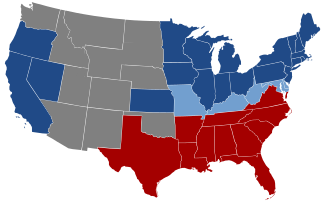(Progressive role of Union) Tag: Visual edit |
(Indigenous genocide) Tag: Visual edit |
||
| Line 1: | Line 1: | ||
[[File:Statesian civil war map.svg|thumb|328x328px|Union in blue and Confederacy in red. Light blue states had slavery but remained part of the Union.]] | [[File:Statesian civil war map.svg|thumb|328x328px|Union in blue and Confederacy in red. Light blue states had slavery but remained part of the Union.]] | ||
The '''Statesian Civil War''' was a civil war between the [[Government of the United States of America|Statesian government]] (the Union) and the [[reactionary]] secessionist [[Confederate States of America (1861–1865)|Confederate States of America]] (CSA) from 1861 to 1865. | The '''Statesian Civil War''' was a civil war between the [[Government of the United States of America|Statesian government]] (the Union) and the [[reactionary]] secessionist [[Confederate States of America (1861–1865)|Confederate States of America]] (CSA) from 1861 to 1865. When the war began, 286 out of over 1,000 Statesian officers joined the Confederate Army.<ref name=":0">{{Citation|author=[[Roxanne Dunbar-Ortiz]]|year=2014|title=An Indigenous Peoples' History of the United States|chapter="Indian Country"|pdf=https://www.lcps.org/cms/lib/VA01000195/Centricity/Domain/10601/An%20Indigenous%20Peoples%20History%20of%20the%20United%20States%20Ortiz.pdf|city=Boston, Massachusetts|publisher=Beacon Press|isbn=9780807000403|page=133–139}}</ref> | ||
== Background == | == Background == | ||
In early 1861, several southern states of the [[United States of America|USA]] seceded to form the Confederate States of America. [[Abraham Lincoln]] succeeded [[James Buchanan]] as [[President of the United States]] in March. The CSA seized the army base at Fort Sumter, [[State of South Carolina|South Carolina]] in April 1861, beginning the war.<ref name=":0" /> | In early 1861, several southern states of the [[United States of America|USA]] seceded to form the Confederate States of America. [[Abraham Lincoln]] succeeded [[James Buchanan]] as [[President of the United States]] in March. The CSA seized the army base at Fort Sumter, [[State of South Carolina|South Carolina]] in April 1861, beginning the war.<ref name=":0" /> | ||
== Indigenous involvement == | |||
Most of the Confederate officers had fought against indigenous nations in [[Settler colonialism|settler colonial]] wars. | |||
The southeastern natives ([[Cherokee]], [[Chickasaw]], [[Choctaw]], [[Muskogee]], [[Seminole]]), who had been forced to move to Oklahoma during the 1830s, were split along class lines, with a tiny [[Slavery|slave]]-owning elite supporting the Confederacy and the majority staying neutral. [[Stand Watie]] of the Cherokee became a general in the Confederate army, but many natives also fought against the CSA. | |||
The Dakota people of [[Minnesota]] were starving by 1862 and began a revolt against the settlers. The Union crushed them and hanged 38 in the largest mass execution in U.S. history. | |||
In 1864, [[Kit Carson]] forced 8,000 [[Navajo]] people to march 300 miles to a concentration camp in the [[New Mexico]] desert. A quarter of the population starved to death.<ref name=":0" /> | |||
== Revolutionary elements == | == Revolutionary elements == | ||
The Civil War began as a war against separatism, and Lincoln did not initially want to abolish | The Civil War began as a war against separatism, and Lincoln did not initially want to abolish slavery. Later, when slaves and former slaves entered the Union army, they turned the war into a [[revolution]] against slavery.<ref name=":122">{{Citation|author=[[Domenico Losurdo]]|year=2011|title=Liberalism: A Counter-History|chapter=Crisis of the English and American Models|page=166|publisher=Verso|isbn=9781844676934|lg=https://libgen.rs/book/index.php?md5=5BB3406BC2E64972831A1C00D5D4BFE4|pdf=https://cloudflare-ipfs.com/ipfs/bafykbzacebhsj2yxuoudkhkjp6lzgr5jvgyhu76zxe4gw3d65gpg32a6nded4?filename=Domenico%20Losurdo%2C%20Gregory%20Elliott%20-%20Liberalism_%20A%20Counter-History-Verso%20%282011%29.pdf}}</ref> After many slaves had already escaped to the North, Lincoln issued the [[Emancipation Proclamation]] in 1863 and allowed them to serve in the Union army.<ref name=":0" /> | ||
== References == | == References == | ||
Revision as of 12:21, 13 July 2023

The Statesian Civil War was a civil war between the Statesian government (the Union) and the reactionary secessionist Confederate States of America (CSA) from 1861 to 1865. When the war began, 286 out of over 1,000 Statesian officers joined the Confederate Army.[1]
Background
In early 1861, several southern states of the USA seceded to form the Confederate States of America. Abraham Lincoln succeeded James Buchanan as President of the United States in March. The CSA seized the army base at Fort Sumter, South Carolina in April 1861, beginning the war.[1]
Indigenous involvement
Most of the Confederate officers had fought against indigenous nations in settler colonial wars.
The southeastern natives (Cherokee, Chickasaw, Choctaw, Muskogee, Seminole), who had been forced to move to Oklahoma during the 1830s, were split along class lines, with a tiny slave-owning elite supporting the Confederacy and the majority staying neutral. Stand Watie of the Cherokee became a general in the Confederate army, but many natives also fought against the CSA.
The Dakota people of Minnesota were starving by 1862 and began a revolt against the settlers. The Union crushed them and hanged 38 in the largest mass execution in U.S. history.
In 1864, Kit Carson forced 8,000 Navajo people to march 300 miles to a concentration camp in the New Mexico desert. A quarter of the population starved to death.[1]
Revolutionary elements
The Civil War began as a war against separatism, and Lincoln did not initially want to abolish slavery. Later, when slaves and former slaves entered the Union army, they turned the war into a revolution against slavery.[2] After many slaves had already escaped to the North, Lincoln issued the Emancipation Proclamation in 1863 and allowed them to serve in the Union army.[1]
References
- ↑ 1.0 1.1 1.2 1.3 Roxanne Dunbar-Ortiz (2014). An Indigenous Peoples' History of the United States: '"Indian Country"' (pp. 133–139). [PDF] Boston, Massachusetts: Beacon Press. ISBN 9780807000403
- ↑ Domenico Losurdo (2011). Liberalism: A Counter-History: 'Crisis of the English and American Models' (p. 166). [PDF] Verso. ISBN 9781844676934 [LG]